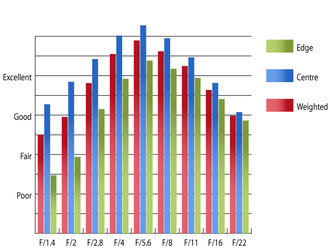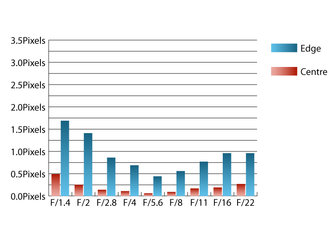Carl Zeiss Planar T* 50mm f/1.4 ZA SSM Lens Review
Carl Zeiss Planar T* 50mm f/1.4 ZA SSM Performance
At maximum aperture, sharpness in the centre of the frame is good, but the clarity recorded towards the edges of the frame is fairly poor. Stopping down the aperture improves performance across the frame with clarity reaching good levels by f/2.8. Peak sharpness across the frame is achieved at f/5.6, where sharpness is outstanding in the centre and excellent towards the edges of the frame.  Resolution at 50mm | How to read our chartsThe blue column represents readings from the centre of the picture frame at the various apertures and the green is from the edges. Averaging them out gives the red weighted column.The scale on the left side is an indication of actual image resolution. The taller the column, the better the lens performance. Simple. For this review, the lens was tested on a Sony Alpha A99 using Imatest. |
Chromatic aberrations are higher than you might expect from a lens bearing the Carl Zeiss name. Fringing at maximum aperture exceed one and a half pixel widths, and will be quite easy to spot along high contrast edges towards the edges of the frame.
 Chromatic aberration @ 50mm | How to read our chartsChromatic aberration is the lens' inability to focus on the sensor or film all colours of visible light at the same point. Severe chromatic aberration gives a noticeable fringing or a halo effect around sharp edges within the picture. It can be cured in software.Apochromatic lenses have special lens elements (aspheric, extra-low dispersion etc) to minimize the problem, hence they usually cost more. For this review, the lens was tested on a Sony Alpha A99 using Imatest. |
Falloff of illumination towards the corners of the frame is fairly typical for a lens with such a fast maximum aperture. At f/1.4 the corners are 2.61 stops darker than the image centre and visually uniform illumination isn't achieved until the aperture is stopped down to f/4 or beyond.
Typical of standard lenses with a fast maximum aperture there is barrel distortion, more than you may expect for a prime lens to present. Imatest detected 2.27% barrel distortion, which may become visible in images with straight lines parallel to the edges of the frame. At least the distortion pattern is uniform across the frame, so this should be realtively easy to correct in image editing software afterwards.
The anti-reflective T* coatings applied to this lens do a sterling job of controlling flare and retaining contrast when shooting into the light. The front element is deeply recessed within the lens barrel also, so there's barely any need for an external hood. A little flare can appear in extreme circumstances when shooting into the light, but contrast is still retained well.
Add your message
Login required
Please login here or if you've not registered, you can register here. Registering is safe, quick and free.
Please login here or if you've not registered, you can register here. Registering is safe, quick and free.
photodo Stats
1102 lenses
428 MTF tests
74 in-depth photodo reviews
100+ users join each day
Help the lens community by reviewing or rating a lens today via our lens search
428 MTF tests
74 in-depth photodo reviews
100+ users join each day
Help the lens community by reviewing or rating a lens today via our lens search
Latest Lens Reviews
- Chinon 28mm f/2.8 Vintage Lens Review
- Canon EF 70-200mm f/4L IS II USM Lens Review
- Samyang AF 85mm f/1.4 EF Review
- Sigma 70mm f/2.8 DG Macro Art Review
- Samyang AF 24mm f/2.8 FE Review
- Meike 50mm f/1.7 Review
- Tamron 70-210mm f/4 Di VC USD Review
- Lensbaby Burnside 35mm f/2.8 Review
- Asahi Super Takumar 50mm f/1.4 Review
- Asahi Super-Multi-Coated Takumar 135mm f/3.5 Review
